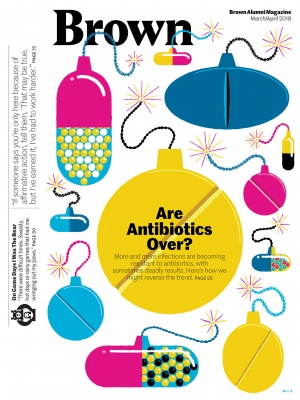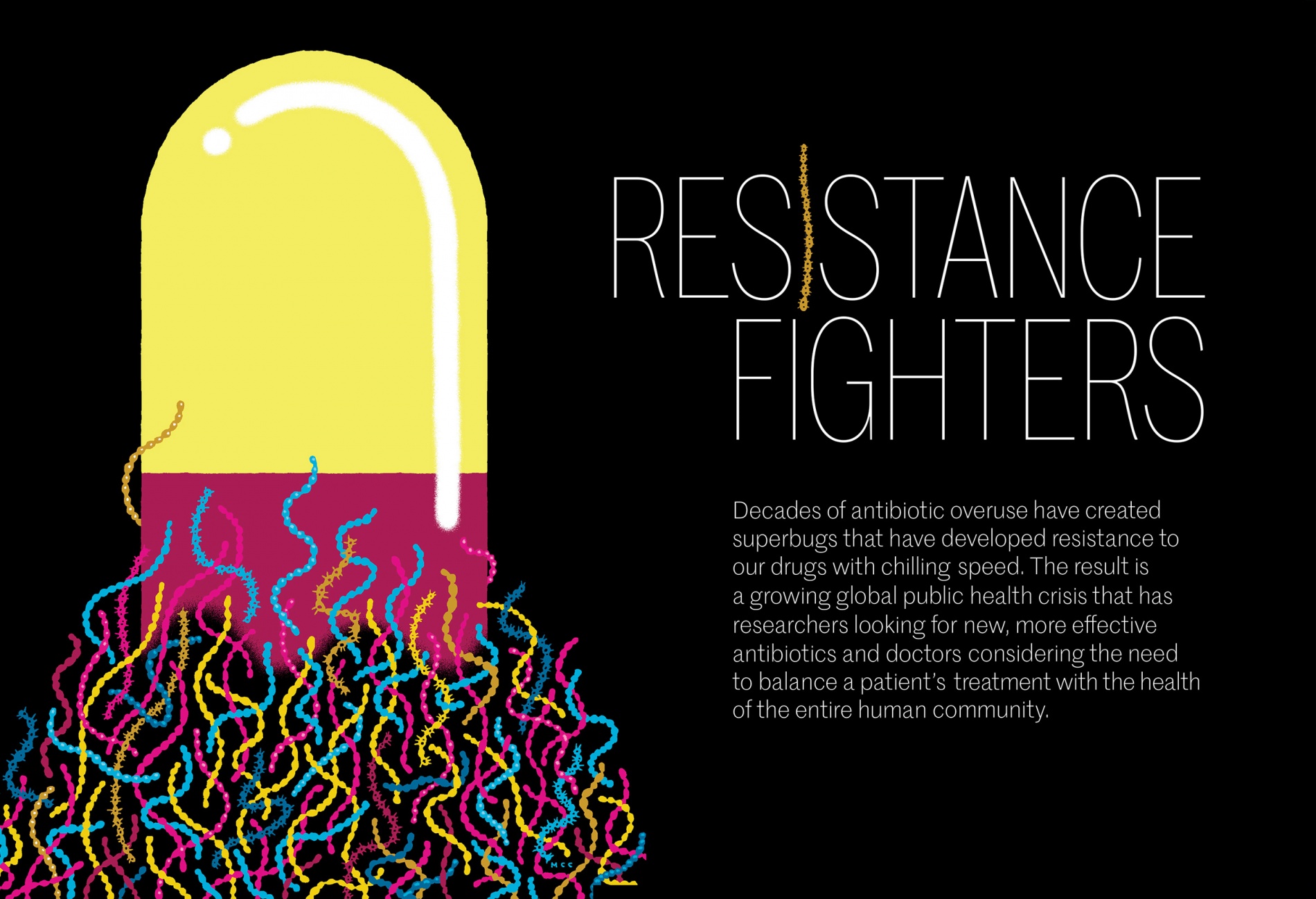
Nobody knows where the infection came from. There was no scratch, no jab that Tori Kinamon ’17 remembers—no breach where the microbes crept in. As a first-year student competing in gymnastics, she was in contact with balance beams, uneven bars, and floor mats, not to mention training tables, weight machines, and locker rooms—all possible avenues of infection. Or maybe she encountered the microbes in her dorm or her home in Peachtree City, Georgia. All she knew is that, not long after the Ivy League Classic, her left hamstring hurt so badly she needed crutches.
Then came flu-like symptoms. Because it was flu season, nobody suspected a cryptic infection masquerading as a strained hamstring. But one more missed diagnosis, one more “Let’s see how you feel tomorrow,” and, Kinamon says, “I definitely would not have been as lucky as I am to have my leg, and maybe even my life.”
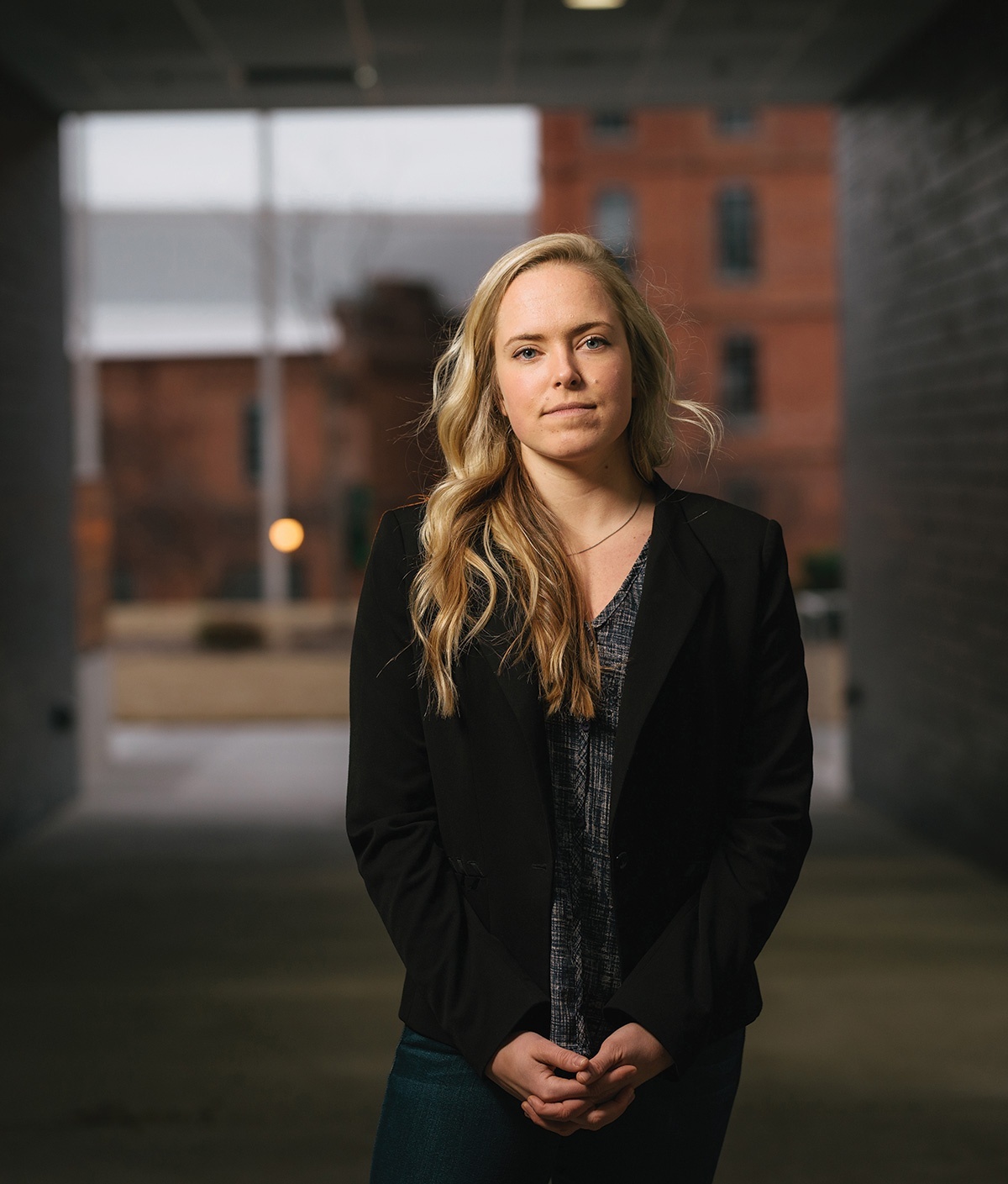
Kinamon, it turned out, was infected with a type of staph infection known as methicillin-resistant Staphylococcus aureus—MRSA for short. Initially a problem in health-care settings, MRSA can also be acquired in the wild. Kinamon didn’t know that athletes are part of a group at increased risk.
She wound up in the ICU and underwent a cautious, exploratory surgery, which was followed by seven others, with her leg finally splayed open to reveal the scourge. A two-foot scar is her permanent memento of a month in the hospital. Before a couple of surgeries, she says, “I went to sleep not knowing if I was going to wake up with two legs.”
How is this possible? Staphylococcus aureus is everywhere—about a third of all people carry it harmlessly in such places as the nose or armpit. Fewer than two percent of people carry the MRSA variety of Staphylococcus, but once once it gets into a wound, or even a pimple, the resulting infection can be serious and, possibly, deadly. Most current antibiotics are powerless against the MRSA bacteria, which, like all such organisms, are quick to evolve.
Decades of antibiotic overuse in medical and veterinary settings have stimulated MRSA to develop antibiotic resistance to more than 100 agents, from methicillin to penicillin to imipenem. And MRSA is just one of many. The World Health Organization (WHO) has identified seven microbes with significant global resistance problems, and the U.S. Centers for Disease Control and Prevention tracks 18. Commonplace bacteria like Salmonella and E. coli, which can cause pneumonia, urinary tract infections, and diarrhea are developing resistance.
“I see it,” says Eleftherios Mylonakis, chief of infectious diseases at Rhode Island Hospital and a Brown professor of medicine, molecular microbiology, and immunology. “I face it. I walk into patients’ rooms and I feel desperation. I have to face the families and this is painful. This. Is. Painful.” Often the deaths are what he calls “horrific”: “They die from diarrhea. This is not the way to die.”
The discovery of new classes of effective antibiotics stalled out in the mid-1980s, but in recent years the federal government has begun to recognize the dangers of antibiotic resistance, responding with new incentives for antibiotic development and a new focus on stewardship of these vital medical resources. The problem of antibiotic-resistant microbes is a grand global challenge that engages scores of governments, hundreds of universities, and thousands of researchers and health care workers.
Associate Professor of Chemistry Jason Sello arrived at Brown in 2006 with a bacterial genus known as Streptomyces on the brain. He calls it his totem microorganism. “We all need inspiration for what we do,” he says. “I like the fact that if you think about Streptomyces you have to think about the connections between chemistry and biology and medicine.” Streptomyces includes about 500 species of mostly soil-dwelling bacteria that are the source of two-thirds of the antibiotics in clinical use.
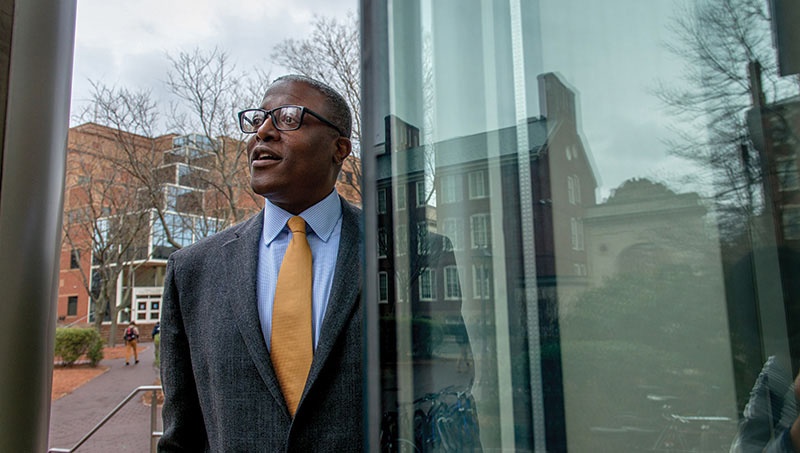
Because Streptomyces look like fungi but are in fact bacteria, Sello calls them a boundary organism that straddles two kingdoms of life. Differences between the kingdoms explain how antibiotics work. Bacterial cell walls and other cellular machinery are very different from those in plant and animal cells, and antibiotics work by targeting those differences. Each new class of antibiotics represents a new insight about how bacteria are put together—and how to take them apart.
Streptomyces can kill rival bacteria by using cyclic acyldepsipeptides, or ADEPs, to interfere with protein degradation. No drug currently uses this mechanism, but to be effective ADEPs need refinement. “You actually have to chemically modify the structures to make them useful in medicine,” Sello explains. If he gets the modifications right, ADEPs would be a new class of antibiotics—the first in more than three decades.
To see if the ADEPs would cure an infected mouse, he teamed up with Mylonakis, who in turn has a collaboration with Harvard researchers to screen new compounds for their antimicrobial properties. Sello also worked with colleagues at MIT to decode the complex structure of the enzymes targeted by ADEPs. The results so far suggest a promising new weapon for a variety of infections, including tuberculosis, our deadliest bacterial foe. Worldwide, 1.7 billion people are TB carriers, though only five to 15 percent will develop the disease. In 2016, 600,000 new cases were resistant to the most effective first-line drug, and more than 80 percent of these were resistant to multiple drugs. Getting an ADEP to work safely against TB would be a major breakthrough.
A 2017 grant from NIH is funding further research into its use for TB. Brown is working both to protect the intellectual property behind Sello’s work and on licensing its further development to a pharmaceutical company for TB and other infections. “I think antibiotic resistance is one of the major public health problems of our time,” he says. “Part of our obligation as academics, particularly those being funded by federal grants, should be to work on things that could impact human health in areas where the pharmaceutical industry has invested lightly.”
Louis Rice, chair of the Department of Medicine at the Warren Alpert Medical School and chief of medicine at Rhode Island and Miriam hospitals in Providence, calls the development of antibiotics “arguably the single greatest health care advance in history.” Not only could we now cure many formerly fatal diseases, our confidence in our ability to treat infection allowed significant advances in treatment of everything from cancer to coronary conditions. “Medical care, as we now know it, could not exist without the availability of effective antibiotics,” he says.
Rice began his career in a time of antibiotic plenty—the early 1980s—when three or four new antibiotics were approved every year. But after he learned about antibiotic resistance, he focused on unraveling the mechanisms of that phenomenon. It was good timing. After Rice graduated from medical school in 1983, the antibiotic pipeline began to constrict.
Meanwhile, other trends contributed to increased resistance. The use of antibiotics in animal feed rose dramatically. Cost cutting in health care reduced staffing, which led to faster bacterial spread in health-care settings. The acceleration of global travel allowed resistance to spread more quickly around the world. At the same time, drug companies began an era of consolidation, and antibiotics didn’t fit their new business model. Why make $100 million on 10-day supplies of antibiotics when there were billions to be made off the never-ending sales of drugs such as Lipitor and Viagra?
Bacteria rapidly exploited the gaps in our defenses. As the planet’s oldest and most resilient life forms, they’ve learned to adapt swiftly. As another doctor said to Rice after they lost an 18-year-old woman to a resistant infection: “When you grow up every 20 minutes you get smart quick.”
In the 1990s Rice’s research included Enterococcus faecium, a common gastrointestinal bug. Late in that decade it began developing resistance to vancomycin, which at the time was the only drug available against MRSA. The fear was that its repeated use would trigger resistance. “We would have nothing to treat staph infections in the hospital,” Rice says. “That got a lot of people’s attention.” At the same time, a much larger group of bacteria was evolving broad resistance to antibiotics. “NIH started to pay attention when they realized that the industry was not going to save us,” Rice says.
Rice has been a vocal proponent for antimicrobial stewardship, a strategic approach to the use of antibiotics and infection control. The problem, he argues, is the indiscriminate use of antibiotics over the past 50 years, which has essentially handed bacteria a blueprint for resistance. Why not use fewer antibiotics and prescribe them with more tactical precision? “Let’s keep our weapons to ourselves so that when we use them they can be more effective,” he says. “I think that’s actually going to work.”
But the economic incentives still need fixing. Most of the little research on how long an antibiotic should be taken has been done by drug companies. “There was absolutely no motivation to shorten courses,” Rice says. Current wisdom insist patients take all the pills prescribed, but Rice suspects many antibiotic courses are too long. More research may help trim their length. And antimicrobial stewardship does not provide any development incentives for drug companies, so Rice and his colleagues have also advocated for government incentives for the development of new antibiotics.
Rice sees some progress: “We’re doing a lot of what we need to be doing,” he says. There is new promise in the development pipeline. Hospitals are getting smarter about infection control and identifying the ways in which everything from building design to staffing practices and laundry processing can affect the spread of resistance.
“The most important thing is for research to inform policy,” he says. “We’ve got to give people antibiotics. They are life-saving drugs and they are safe in many ways.”
Peter Belenky, an assistant professor of molecular microbiology and immunology, likes to tell the story of William Hewson to his young microbiologists. A British physician and a contemporary of Ben Franklin in London, Hewson enjoyed a brief resurgence of fame in 1998 when workmen found 10 skeletons—probably cadaver remains from his dissection work— buried in his cellar.
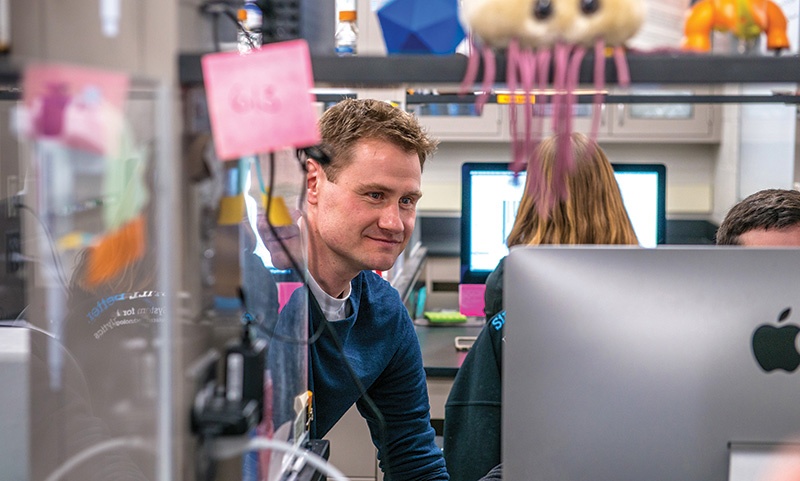
One of those cadavers may well have carried the infection that Hewson contracted through a small cut in his hand. It killed him, in 1774, in just three days. “A guy my age—kids, family—and there was nothing anybody could do about it,” Belenky says. “That is the world before antibiotics. Bacteria are wonderful and awesome and everything, but being able to control them has really changed the way we think about life.”
Belenky is intrigued by bacterial metabolism and how antibiotics affect it. Bacteria have three ways to acquire new genes, and antibiotics possibly accelerate this remixing, which can lead to resistance. Understanding how bacteria acquire resistance genes “can be very potentially important in fighting this crisis,” he says.
If the same endless bacterial competition that produces antibiotics also produces antibiotic resistance, how can we control that process to control resistance? “Penicillin resistance happens three years after the introduction of penicillin not because [the bacteria] came up with something new,” Belenky says. “It’s because they, in a predictable way, stole a gene from another bug.”
Similarly, he says, the solution to that problem might be a lot simpler than we think: “I’m finding ways to make the current drugs work better.” For example, working with diabetic mice, Belenky has found that blood sugar may affect antibiotic response. “Sugar levels affect microbial susceptibility to antibiotics,” he says. “Perhaps it makes sense to take care of the underlying diabetic symptoms as you administer antibiotics.”
To wage such a nuanced fight, we need rapid diagnostic tests. Belenky is helping one company hit an ambitious CDC goal: identifying an infectious agent, learning what resistance genes it’s carrying, and determining what antibiotics it’s likely to respond to—all in two hours. “That gives the physicians so much power,” he says. “It’s easy to just tell physicians to prescribe fewer antibiotics. You have to give them an alternative.”
Belenky is also looking for diagnostic clues in the human microbiome. Many people who develop resistant infections carry the seeds of infection among their intestinal microbes. What makes them break out? For example, another of his Brown collaborators, Associate Professor of Medicine Erika D’Agata, recently published results suggesting that patients with more lactobacillus bacteria are less likely to have resistant organisms present in their gut. If that finding holds, it suggests a simple test to determine which patients are at greater risk of acquiring a resistant bug, which could affect both their treatment options and the level of precaution undertaken by providers. “We are going to benefit tremendously from understanding both the microbiome and the imbalanced microbiome,” Mylonakis adds.
Resistant infections are no longer a problem restricted to a few NFL facilities or the unlucky hospital patient. These bugs are in the wild. At least 2 million people in the United States become infected with resistant bacteria every year, and 23,000 die—a major factor in rising health-care costs. The elderly are particularly vulnerable, and with baby boomers aging they are likely to be increasingly affected. “Over the past decade we’ve begun to realize that nursing homes are one of the major reservoirs of these resistant bacteria,” D’Agata says. These facilities have many of the same environments for spreading antibiotic-resistant bacteria as hospitals, but the exposure is more likely. In a population with more urinary tract infections, more incontinence and diarrhea, and with more communal spaces, bacteria can more easily spread. Most nursing homes do not have the resources or expertise to prevent this infectious environment.
D’Agata is leading a five-year study to look at transmission dynamics in nursing homes with dementia patients. She wants to develop specific prevention strategies different from those used in a hospital, where stays are short and the staff-patient ratio is higher. She’s already tackled the problem in dialysis centers, another hot spot of resistance. Her pilot program in New Jersey involved six centers and led to a significant decrease in antibiotic prescriptions in just one year.
D’Agata is heartened by a growing awareness. Ten years ago people had no idea about the impact of resistant bacteria. If a child had a sore throat, parents always asked for antibiotics. “That has actually changed quite a bit,” she says. Many patients now ask if they really need antibiotics at all. “I think the community is starting to understand that antibiotics have downsides,” she says.
Mylonakis is more cautious. “I tend to be alarmist,” he admits. While the government has mandated antimicrobial stewardship and has begun to reward antimicrobial discovery, these efforts are uncoordinated and still relatively few. “Pharma needs to get engaged,” he says. “There are some signs of hope, but we are still at the very early stage.”
It’s a unique moment: Most people alive today—and virtually all medical practitioners—can’t recall a time before antibiotics. They’ve profoundly influenced the practice of medicine. Now we must navigate their potential for causing serious harm and even death. Septic shock is the result of a bacterial infection run amok, and it is one of the gravest challenges for physicians and patients. Not very long ago it was common to throw three, four, and even five antibiotics at a raging septic infection. “Clearly, when you have a mortality rate that goes up by the hour, throw everything,” Mylonakis says.
Antimicrobial stewardship dictates a more restrained approach, a need both to maintain the antibiotic resource and to decrease the risk for other patients. It does seem chilling when viewed from the perspective of a single patient. “I’m not in favor of programs that tell doctors what they can or can’t do with a very sick patient,” notes Rice. But after 48 hours, he says, the game changes, and the focus has to be on pulling back with an eye on the broader good.
Antibiotic resistance is the product of an entire health-care ecosystem—not just doctors—and stewardship needs to permeate that entire system. “This is in many ways similar to global warming,” says Belenky. He adds, wryly, “But the U.S. government is actually fighting it.”
As Mylonakis reminds us, antibiotic resistance presents physicians with a difficult moral as well as scientific problem, requiring them to consider the balance between the individual and the community. “As clinicians,” he says, “we were always trained to do the best for this particular patient, right now. Now we have to balance that. This is the most meaningful shift, and the most difficult one.”
Erik Ness is a science and environmental writer based in Wisconsin.

